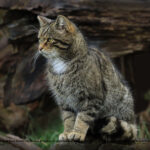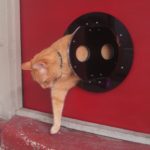Catios
 Catios are now a popular addition to the homes of cat owners around the world. What exactly is a catio, and is it the right thing for your home and your cats? How will one fit in with your budget, lifestyle, cats and local laws? And if your cat has FIV, is this the ideal solution to giving them outdoor time?
Catios are now a popular addition to the homes of cat owners around the world. What exactly is a catio, and is it the right thing for your home and your cats? How will one fit in with your budget, lifestyle, cats and local laws? And if your cat has FIV, is this the ideal solution to giving them outdoor time?
This post looks at all things catios to help you decide whether to install one, and if so what to consider.
Catios explained
In a nutshell a catio is an enclosed outdoor space for cats to spend time in, often but not always attached to a house, but they can be so much more than that. The possibilities are endless – size, shape, location, furnishings, construction materials, access and on and on.
There’s a lot to think about and we’ll break that down. But first we look at restrictions on cats around the world, and why catios can be an effective solution.
Cat freedoms around the world
In many countries laws exist on having cats microchipped, but some go further. Many areas of New Zealand have local laws requiring cat owners to have their cats chipped and registered but also desexed, to keep down the population of unwanted and feral cats. It’s expected that this will be enforced across the whole country eventually, together with laws restricting the freedom of cats to roam. This aligns with New Zealand’s aim to be free of non-native predators such as stoats, rats and possums, by 2050. These predators pose a huge and unsustainable risk to New Zealand’s native flightless birds. However, cats undoubtedly help to keep rats under control and humans also have a negative impact on wildlife, so this is not a clear cut situation.
Melbourne City Council has passed a law, effective from October this year, requiring all cat owners to keep their cats in between 8 o’clock at night til 6 o’clock in the morning. In addition cats will be banned from waterways and the biggest parks 24 hours a day unless on a leash and with their owner. This is is to protect local wildlife.
There have been some unhelpful rumours about the most extreme measures, cat bans. A rumour went viral recently claiming that cats were going to be banned in New Zealand. As is often the way with social media phenomena it’s hard to pinpoint exactly where this started, but it seems to have taken off in response to increasing regulation around cat ownership and freedoms.
 In February this year the First Minister of Scotland, John Swinney, had to confirm that the Scottish government had “absolutely no intention of banning cats. There’s no way that’s going to happen,”. This rumour took hold after the Scottish Animal Welfare Commission advised the Scottish government to look into “compulsory containment” of cats in order to protect wildlife, the same reason that New Zealand is tightening its laws. In Scotland protection of the Scottish wildcats is a particular concern and the SAWC urged legislation for housing developments in rural areas, where domestic cats and wildcats are most likely to meet.
In February this year the First Minister of Scotland, John Swinney, had to confirm that the Scottish government had “absolutely no intention of banning cats. There’s no way that’s going to happen,”. This rumour took hold after the Scottish Animal Welfare Commission advised the Scottish government to look into “compulsory containment” of cats in order to protect wildlife, the same reason that New Zealand is tightening its laws. In Scotland protection of the Scottish wildcats is a particular concern and the SAWC urged legislation for housing developments in rural areas, where domestic cats and wildcats are most likely to meet.
Catios as a solution
 In the context of protecting wildlife, a catio is an immediately effective measure to keep cats and vulnerable species apart. Your cats can still see, hear and smell everything outdoors just as if they were roaming free so benefit from stimulation and natural behaviours.
In the context of protecting wildlife, a catio is an immediately effective measure to keep cats and vulnerable species apart. Your cats can still see, hear and smell everything outdoors just as if they were roaming free so benefit from stimulation and natural behaviours.
As other cats can’t get into your enclosure, there is no need for a microchip catflap. While we 100% support microchipping of cats, microchip catflaps themselves can malfunction with cats sometimes being locked out. As your cats are going between your home and their catio with no access for any other cats, you can install the best solution without worrying about microchips.
Wider benefits to your cat include protection against injury, attack or theft. No more fights with the local feline bully or risk of injury such as catching their collar on a fence post, something that does happen, sadly. Your cat is also protected to some extent against coming into contact with contagious feline diseases, although this is not so much the case if neighbourhood cats can come right up to your catio. Your cats are also protected against coming into contact with plants that can harm them. In the UK this includes the very popular daffodil. You can read about plants dangerous to cats here.
Some cats must be kept inside due to diseases that they carry. The main one is feline immunodeficiency virus, which must not be transmitted to other cats. You can find out more here.
If you have a balcony and are worried about your cat falling, you can enclose the balcony to form a catio. This gives your cat greater freedom to be in the sun and fresh air and completely removes the risk.
Catios by design
 A quick web search returns thousands of results for catio designs. The sky is literally the limit. Depending on your budget and your preferences there are endless choices.
A quick web search returns thousands of results for catio designs. The sky is literally the limit. Depending on your budget and your preferences there are endless choices.
The first choice to make is whether to hire a builder or do it yourself. There are DIY catio guides available, including this one.
If you’re hiring a tradesperson to do it, you can see if a specialist catio builder works in your area. They should provide a design service but it’s useful to think ahead of time about your priorities and of course your budget.
A top priority must be the sturdiness and safety of the catio. Your cat and potentially people will be spending a lot of time there so you need to be sure the structure can take endless leaping about and climbing, by cats and people. If small children will have access to the space the usual safety considerations apply.
Materials are the next consideration. If your basic materials are wood and chickenwire, you can probably source some of this from reclaimed materials. Check which treatments if any have been applied to the wood. You need to be sure they aren’t toxic to your cats and wildlife. This is also something you’ll need to check if you apply wood treatment yourself at any stage. An alternative is a metal framework. Flatpack catios are available that come with everything you need. Except perhaps a strong drink.
 When you’re looking at the design of your catio, build in access. Building a catio coming straight off a back door is likely to be impractical so you’re most likely to be looking at a catflap through a window or wall. The Petflap draughtproof pet door is ideal for this. Your cat has 24 hour access to a safe space through a draughtproof exit point that could be opening straight into your sitting room or hallway. Some access arrangements are very intricate and fun for cats, including chutes, ropes and multiple steps.
When you’re looking at the design of your catio, build in access. Building a catio coming straight off a back door is likely to be impractical so you’re most likely to be looking at a catflap through a window or wall. The Petflap draughtproof pet door is ideal for this. Your cat has 24 hour access to a safe space through a draughtproof exit point that could be opening straight into your sitting room or hallway. Some access arrangements are very intricate and fun for cats, including chutes, ropes and multiple steps.
Shade is another important consideration. Cats love to laze in the sun but they need access to outdoor shade. This can be provided by large (safe) plants, enclosed cat beds and other fixtures and furnishing. Think about how the sun tracks across hour outdoor space and try to position the catio so it’s not in full sun for hours on end.
Once the design, position, access and shade are in place you can have fun deciding how to furnish the catio. Catios benefit from a litter box and might prevent the need for one in the house which is always a plus. You might choose to feed your cat and provide water in the catio. For this type of use it’s of course necessary for humans to have easy access to the catio through a door in the wire which is generally a good idea. This isn’t practical with a balcony unless you’re a champion abseiler.
Some catios are one step short of a cat palace with electricity and heating, but most cats will be happy with steps to jump about on, toys and comfortable lounging spots.